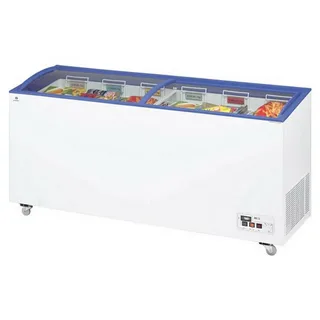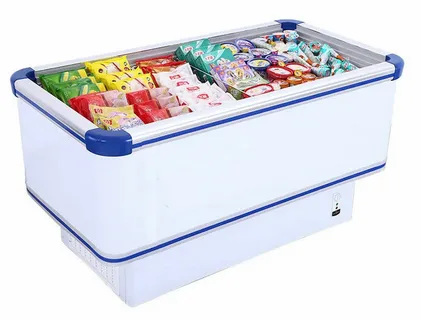Every restaurant, supermarket, or food-related business relies heavily on a robust cold storage system. Commercial chest freezer offer unique benefits among the various types of refrigeration options. They are popular in the food industry for their versatility, spaciousness, and energy efficiency. Let’s delve deeper into evaluating the utility of Commercial freezers.
An Overview of Commercial freezers
Commercial freezers are refrigeration units widely utilised in food and retail. They are characterised by their horizontal, rectangular design with a lid on the top that opens upwards, providing easy access to the contents stored inside. These units offer significant storage capacity and denser cold air and remain at the bottom of the freezer even when the lid is opened. They are highly versatile and can store many items, from frozen foods and ice cream to perishable goods that require a consistently cold temperature.
Commercial appliances are designed to withstand heavy-duty usage and are constructed from high-quality, durable materials to ensure longevity. Moreover, modern Commercial freezers incorporate various features and technologies to enhance their efficiency, usability and energy conservation. The choice of a Commercial freezer ultimately depends on the business’s specific needs and spatial confines, making the evaluation process essential.
Key Advantages of Commercial freezers
Commercial freezers have several distinct benefits that enhance their attractiveness for businesses in the food sector.
• Efficient Temperature Maintenance:
The design of chest freezers facilitates better cold air retention, as the cold air sinks and remains within the freezer even when the lid is opened. This feature ensures consistent temperature control, which is essential for preserving stored products’ quality.
• Substantial Storage Space:
Their horizontal design offers considerable storage space, which can accommodate a large number of products, enhancing the ability of a business to handle increased demand or stock up on supplies.
• Energy Efficiency:
As detailed earlier, chest freezers typically display higher energy efficiency than other freezers. This characteristic translates into long-term cost savings, thereby adding to their appeal.
• Robust Durability:
Commercial freezers are built for heavy-duty usage, using high-quality, resilient materials, ensuring their ability to withstand the rigours of a bustling commercial environment.
• Versatility:
The broad application scope of these freezers enhances their utility. They are equally adept at storing different food products, ranging from frozen items to fresh produce requiring consistent cooling.
Evaluating the Capacity and Size of Commercial freezers
The size and capacity of Commercial freezers are fundamental factors to assess before making a purchase decision. These units are offered in a diverse range of sizes, from petite models designed to fit seamlessly in limited spaces to expansive units catering to larger establishments such as supermarkets or restaurants. The selected size and capacity should directly correspond to the storage necessities of the business.
Furthermore, the spatial confines of the premises should also be considered. The larger the freezer, the more space it will require, both for its physical presence and adequate ventilation. Therefore, an in-depth understanding of the business’s storage needs and an evaluation of available space is essential when determining the appropriate size and capacity of a Commercial freezer.
Assessing the Energy Efficiency of Commercial freezers
When one explores the option of a Commercial freezer, energy efficiency is a crucial aspect that requires scrutiny. Models with high energy efficiency utilise less power, yielding significant savings in electricity costs over time. The freezer’s energy rating clearly indicates this efficiency – the higher the rating, the greater the energy efficiency.
Additionally, models engineered with advanced insulation and cutting-edge cooling technology display enhanced energy efficiency. Hence, a thorough assessment of these elements is vital in gauging the energy efficiency of a Commercial freezer.
Exploring the Various Features of Commercial freezers
Commercial freezers encompass many features developed to enhance user experience, operational efficiency, and practicality. The incorporation of these features varies depending on the specific model and brand. Nonetheless, several common elements often form part of their design.
• Adjustable Thermostat:
Almost all Commercial freezers have an adjustable thermostat. This allows for precise temperature control, ensuring the freezer maintains the optimal temperature required to preserve different food products.
• Digital Temperature Display:
This feature provides a clear, real-time reading of the internal temperature, making it easier for the staff to monitor and adjust without opening the freezer lid, thus reducing cold air loss.
• Interior Lighting:
Interior lighting aids visibility, especially in dimly lit environments. It allows users to locate and retrieve items more easily, particularly during peak business hours when efficiency is paramount.
• Lockable Lid:
A lockable lid feature enhances security, particularly in businesses that remain open round the clock. It prevents potential theft and helps avoid accidental lid opening, preserving the internal temperature and energy consumption.
• Castor Wheels:
Many Commercial freezers incorporate castor wheels, enhancing their mobility. This feature facilitates the easy moving of the freezer during cleaning or rearrangement of the premises without having to empty its contents.
These are just a few features that could be present in a Commercial freezer. However, only some businesses may require all these features. Hence, an understanding of the business’s specific needs and operational processes aids in identifying the most useful features and selecting an apt Commercial freezer.
Understanding the Maintenance Requirements of Commercial freezers
Maintaining Commercial freezers is vital for their optimal functionality and long-lasting service. The maintenance regime mainly revolves around regular cleaning and defrosting. Despite some high-end models featuring a frost-free operation, most chest freezers require periodic manual defrosting to prevent frost build-up, which can hamper the appliance’s efficiency. The defrosting process involves switching off the unit, removing the contents, and allowing the ice to melt.
The interior should be cleaned using mild soap and warm water, carefully avoiding harsh detergents or abrasive materials that could damage sunit. Routine cleaning should also extend to the exterior, ensuring it remains free from dust and grime. Attention should be given to the freezer’s seals, as any damage can lead to cold air leakage, reducing the unit’s efficiency and increasing energy costs. Therefore, regular inspection of the seals and prompt replacement, if required, is an integral part of maintenance.
Another crucial maintenance aspect is the regular monitoring of temperature. Any irregular fluctuations can signal potential issues that may need professional attention. Most models come equipped with an adjustable thermostat and digital temperature display, aiding in easily monitoring and controlling the internal temperature.
Exploring the Cost of Commercial freezers
The cost of Commercial freezers can vary significantly depending on various factors. Size and capacity often dictate the price, with larger units generally bearing higher costs due to their enhanced storage capacity. Brand reputation also influences the price, with established brands that offer longer warranties and after-sales service often demanding a premium.
The energy efficiency rating of the freezer, though initially leading to a higher purchase price, can result in substantial savings in the long run through reduced electricity bills. Including advanced features like digital temperature displays, adjustable thermostats, interior lighting, and castor wheels can also impact the price. Similarly, the material and build quality of the freezer are integral price determinants.
High-quality, robust materials and construction typically entail higher costs, reflecting the durability and longevity they promise. It’s crucial, however, for businesses to consider not just the initial purchase price but also the ongoing operational and maintenance costs whilst evaluating the overall cost-effectiveness of a Commercial freezer. It would be prudent to compare various models on these aspects, thus ensuring a balance between upfront costs and long-term value.
Navigating the Market for Commercial freezer
Navigating the market for Commercial freezer can be intricate due to the many brands, models, and features available. Key to the selection process is to focus on individual business needs, space availability, energy efficiency and financial considerations. One can start by shortlisting reputable brands known for their quality and reliable after-sales service. Reading user reviews and seeking recommendations from similar businesses can provide useful insights into the durability, performance and customer satisfaction associated with different models.
Comparing the technical specifications, energy ratings, and additional features across models proves advantageous. Moreover, checking the warranty details can provide an added layer of assurance. Businesses with budget constraints might consider exploring the used freezer market, although scrutiny of such appliances for any signs of wear or performance issues is necessary. In contrast, larger establishments with extensive storage needs and higher budgets may customise their freezers to their requirements.
Ultimately, successful navigation through the market demands a careful balance between the immediate needs, long-term operational costs and the potential value derived from the Commercial freezer.
 Making the Most of a Commercial Chest Freezer
Making the Most of a Commercial Chest Freezer
Maximising the utility of a commercial chest freezer calls for its efficient organisation and appropriate usage. With their considerable capacity, these freezers can easily become cluttered, making it challenging to locate items quickly. Thus, creating an organised system for storing items, such as categorising products and employing storage bins, can significantly enhance retrieval efficiency. Additionally, placing frequently accessed items towards the top can help minimise cold air loss during the search.
Understanding and adhering to the optimal temperature for different food items can also enhance a Commercial freezer’s effectiveness. For instance, while ice cream is best stored at -18 °C, most other frozen foods require around 20°C. Commercial freezers are also ideal for batch cooking or preserving seasonal produce. As businesses often deal with bulk ingredients, converting them into ready-to-use preparations and storing them in a chest freezer can save considerable time and effort during peak business hours.
However, one must not forget to rotate the stock regularly to maintain product quality and prevent spoilage. Implementing a system like ‘First-In, First-Out’ can be beneficial in ensuring the freshness of the stored products.
FAQ’s
• What are the energy efficiency ratings in commercial chest freezer?
Energy efficiency ratings provide a measure of the commercial chest freezer energy consumption. The higher the rating, the greater the efficiency and potential long-term cost savings.
• Can a Commercial freezer operate in frost-free mode?
While some high-end models offer frost-free operation, most Commercial freezers require periodic manual defrosting to maintain efficiency.
• What is the optimal temperature for storing food in a Commercial freezer?
The optimal temperature can vary. For example, ice cream is best stored at -18 °C, while most frozen foods require around 20°C.
• Are there options for used Commercial freezers?
Yes, the used freezer market can offer options for budget-constrained businesses. However, these appliances require thorough scrutiny for signs of wear or performance issues.
• How do you maintain an organisational system inside a Commercial freezer?
Utilising categorised storage bins and placing frequently accessed items towards the top can enhance retrieval efficiency and minimise cold air loss. Regular stock rotation following a ‘First-In, First-Out’ system can also ensure the freshness of the stored products.
Concluding Remarks on Commercial freezers
In summary, commercial chest freezer emerge as highly adaptable and effective appliances for entities operating in the food sector. While selecting an apt model demands meticulous scrutiny of various aspects, the inherent merits of chest freezers justify the investment. Exhibiting a generous capacity, notable energy efficiency, and enduring longevity,
Commercial freezers deliver superior value and practicality. This, in turn, has firmly established them as a vital component within numerous commercial culinary environments. The emphasis, however, remains on conducting comprehensive research and considering individual business needs to capitalise fully on the benefits these versatile units provide.
| Other Good Articles to Read |
| Blogs Rain |
| Cme Blog Spot |
| Garcias Blogs |
| Yyc Blogs |
| Guiade Blogs |
| Blogs-Hunt |
| Impact-Blog |
| Smarty Blogs |
| Ed Blog |
| Mo Blogs |
| Blogs Em |
| Blogs T |
| Related Business Listings |
| Contact Directory |
| Local Business Profiles |

